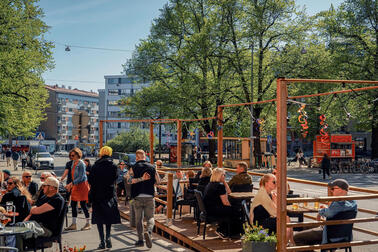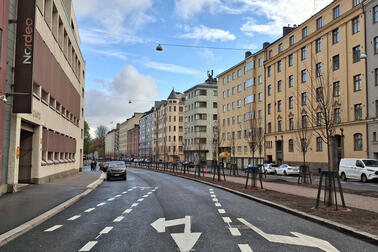
The aim of the Esplanade experiment is to increase the vitality of the city centre, improve the conditions for walking and living and obtain information on the fluency of the arrangements for designing permanent solutions both in the Esplanade streets and other similar streets. The effects of the trial will be monitored throughout the experiment. The results now obtained were collected between September 2023 and April 2024.
Companies did not benefit from the winter season of the Esplanade streets
In light of the results of mobile data, the Esplanade experiment has not attracted more people to the area. The number of people visiting the Esplanade area during the day and the number of shorter visits increased by one percent compared to the previous winter season. At the same time, the number increased by 4% in the railway station area, which was selected as a reference area. Time spent in the Esplanade area decreased slightly. In general, the number of visitors and stays in the centre of Helsinki have developed less favourably than in Oslo and Stockholm, for example.
During the winter season, the sales of the companies in the area developed less favourably than in the summer. However, factors affecting turnover cannot be identified, because in addition to the experiment, the change is also influenced by inflation, the growth of e-commerce and the general global situation, for example.
The experiment was not considered to have brought much added value to companies in the winter season. Companies' attitudes towards the experiment were also more negative than in the summer season.
Less car traffic, seasonal variation in the amount of pedestrian and bicycle traffic
Pedestrian numbers vary at different times of the year throughout the city centre. The highest pedestrian numbers in 2023 were recorded especially near Stockmann in Pohjoisesplanadi and Keskuskatu in December, owing to Christmas shopping visits, for example. The number of pedestrians in the city centre’s streets also remained higher in February 2024 than in the spring of 2023.
Operators in the area felt that the experiment as well as the winter had a negative impact on the area’s service traffic. Illegal parking at loading areas was common during the winter season, which made in more challenging to find a vacant loading area and led to occasional driving on pavements.
There were several construction sites in the city centre in 2023, so there was less car traffic than usual in Kaivokatu, for example. After the start of the Esplanade experiment, the volumes of car traffic especially in the Esplanade streets decreased by 18–20% and remained at a lower level than in spring 2023 also in the winter season 2024. Some of the car traffic has switched to alternative routes instead of the Esplanade streets, though the transition has been moderate.
The fluctuation in the volumes of bicycle traffic was mainly considered normal seasonal fluctuation. The number of cyclists in Eteläesplanadi was at a normal level. The arrangement of the experiment improved cycling conditions but did not bring about a significant change.
In Lönnrotinkatu, the number of cyclists remained low compared to the busiest cycling routes. In some places, the bicycle lane was blocked by parked cars and ploughed snow.
In the winter season 2024, the fluency of car traffic weakened most in Pohjoisesplanadi compared to the previous year. The spill-over effects were also visible at Meritullintori and at the southern end of Pohjoisranta, especially in the morning rush hour. No significant weakening of the traffic flow was observed on other transverse routes in the city centre during the winter season. On average, travel times on the city centre’s transverse routes in winter increased by about 10% compared to the winter of 2023, and the impact of the experiment on car traffic travel times was on average similar in the summer season. However, travel times in the winter of 2024 decreased on several routes compared to the autumn of 2023. However, there were route-specific differences in the changes, due to street works.
The area was mainly used as a pass-through area in winter
Public furniture in the Esplanade extension areas was used relatively little in the winter and, as a rule, much less than in the summer season. There were no terraces in the experimental area in the winter season. In winter, the use of the space was more focused on passing through it than on staying.
Traffic light prioritising arrangements for emergency vehicles will be continued
Street construction and experiments related to the pedestrian city centre have slowed down emergency vehicle traffic. The Rescue Department’s response time is monitored more closely in Kruununhaka and Katajanokka in central Helsinki. The Erottaja rescue station has deployed a priority arrangement for traffic lights for emergency vehicles. The experiences of rescue personnel about the functionality of the system in spring are positive and the system has been considered to be useful. The closer monitoring began in June 2023, at the same time as the experiments on the Esplanadi streets started. The monitoring will continue until further notice even after the Esplanadi experiment ends.
The experiment will continue until autumn 2024
For next summer, we will improve cycling and car traffic signage and service traffic area markings in the Esplanadi experimental areas. The planting of summer flowers has started and a summer street and event stage were also built in Korkeavuorenkatu in front of the Design Museum for the summer.
The Esplanade experiment will continue throughout the summer. The experiment will end and the areas will be returned to the state before the experiment after the end of the terrace season in November 2024.
Monitoring will be carried out throughout the experiment. The final monitoring results will be completed in early 2025, at which point final conclusions can be drawn about the effects of the experiment.


